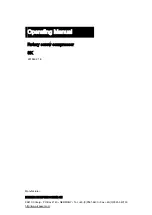
Instruction Manual
2954 2510 03
11
2 The supervisor, or the responsible person, shall at all times make sure that all instructions
regarding machinery and equipment operation and maintenance are strictly followed and that
the machines with all accessories and safety devices, as well as the consuming devices, are in
good repair, free of abnormal wear or abuse, and are not tampered with.
3 Whenever there is an indication or any suspicion that an internal part of a machine is
overheated, the machine shall be stopped but no inspection covers shall be opened before
sufficient cooling time has elapsed; this to avoid the risk of spontaneous ignition of oil vapour
when air is admitted.
4 Normal ratings (pressures, temperatures, speeds, etc.) shall be durably marked.
5 Operate the unit only for the intended purpose and within its rated limits (pressure, temperature,
speeds, etc.).
6 The machinery and equipment shall be kept clean, i.e. as free as possible from oil, dust or other
deposits.
7 To prevent an increase in working temperature, inspect and clean heat transfer surfaces (cooler
fins, intercoolers, water jackets, etc.) regularly. See the
4.5 Preventive maintenance schedule
for the compressor
8 All regulating and safety devices shall be maintained with due care to ensure that they function
properly. They may not be put out of action.
9 Care shall be taken to avoid damage to safety valves and other pressure-relief devices,
especially to avoid plugging by paint, oil coke or dirt accumulation, which could interfere with
the functioning of the device.
10 Pressure and temperature gauges shall be checked regularly with regard to their accuracy. They
shall be replaced whenever outside acceptable tolerances.
11 Safety devices shall be tested as described in the maintenance schedule of the instruction
manual to determine that they are in good operating condition. See the
4.5 Preventive
maintenance schedule for the compressor
.
12 Mind the markings and information labels on the unit.
13 In the event the safety labels are damaged or destroyed, they must be replaced to ensure
operator safety.
14 Keep the work area neet. Lack of order will increase the risk of accidents.
15 When working on the unit, wear safety clothing. Depending on the kind of activities these are:
safety glasses, ear protection, safety helmet (including visor), safety gloves, protective clothing,
safety shoes. Do not wear the hair long and loose (protect long hair with a hairnet), or wear
loose clothing or jewelry.
16 Take precautions against fire. Handle fuel, oil and anti-freeze with care because they are
inflammable substances. Do not smoke or approach with naked flame when handling such
substances. Keep a fire-extinguisher in the vicinity.
1.3
Safety during transport and installation
When towing, lifting or transporting the compressor in any way, the battery switch must always be
in the “OFF” position!
To lift a unit, all loose or pivoting parts, e.g. doors and towbar, shall first be securely fastened.
Do not attach cables, chains or ropes directly to the lifting eye; apply a crane hook or lifting shackle
meeting local safety regulations. Never allow sharp bends in lifting cables, chains or ropes.
Helicopter lifting is not allowed.
It is strictly forbidden to dwell or stay in the risk zone under a lifted load. Never lift the unit over
people or residential areas. Lifting acceleration and retardation shall be kept within safe limits.
Содержание XRHS 1100 CD6
Страница 2: ......
Страница 8: ...Instruction Manual 8 2954 2510 03 ...
Страница 111: ......
Страница 112: ...Printed in Belgium 04 2007 2954 2510 03 www atlascopco com ...












































